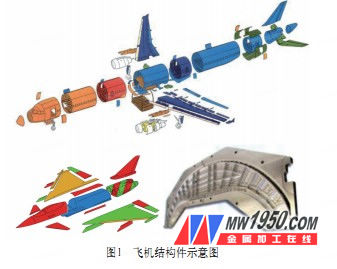CNC machine tools are the key equipment of modern manufacturing. The output and technical level of a national CNC machine tool represent the manufacturing level and competitiveness of the country to some extent. So far, the technical level, performance and quality of CNC machine tools in China are still far from those in foreign countries. Simple CNC lathes with low technical content still dominate. High-end CNC machine tools and functional components mostly rely on imports.
Therefore, although the current market is active and demand is strong, if you do not understand the development trend of foreign CNC machine tools, continuously improve the ability of independent development, and actively cultivate new products, then you can not meet the requirements of sustainable development of the national economy. The aviation industry is an industry that drives the development of numerical control technology. The emergence of many new technologies is related to the needs of the aviation industry. The research and development of new CNC machine tools for processing aircraft structural parts is of great significance for the development of China's CNC machine tool industry.
Aircraft structural parts characteristics and processing requirements
The machining of aircraft structural components is a major component of aircraft manufacturing engineering. In the past, large structural parts of aircraft were often assembled from many parts. In recent years, the overall design principle of aircraft structural parts has received more and more attention. The basic concept of the overall design is to cut the metal from a single blank to obtain a monolithic structural part with superior performance. Its advantages are not only shortened the processing assembly cycle and logistics chain, but also reduce the weight of structural parts, which is very important for modern passenger aircraft and fighter aircraft.
Aircraft structural components include fuselage, wings, bulkheads and ribs, most of which are thin-plate parts with numerous complex holes, cavities, grooves and stiffeners, as shown in Figure 1. The material is mainly high-strength aluminum alloy, and the blank is an aluminum plate or aluminum ingot of 60-300 mm thick, and the length is 1-30 m.

The commonality of the whole structural parts processing is that the metal removal rate of the blank is above 80%, and even up to 95% for the new type of fighter. Due to the extensive use of 3D CAD and finite element analysis in the design of aircraft structural parts, the structure is continuously optimized, and the material properties are fully utilized, so that it is possible to significantly reduce the weight while increasing the strength of the structural member. This inevitably leads to a complicated structure, a large number of holes, and a thin wall thickness, which must be processed using a 5-axis CNC machine tool.
After further analyzing the processing technology of modern aircraft structural parts, the following requirements are generally proposed for the new generation of CNC machine tools:
(1) The machining efficiency of the machine tool is high, the metal removal amount is large, and the spindle can provide sufficient power for high-speed milling.
(2) The machine tool has high precision and reliability, stable performance, and can guarantee the processing quality without relying on the inspection process after processing.
(3) Process intensification, all processes are completed as much as possible on one machine tool, and the tool magazine capacity is more than 100 tools.
(4) Convenient loading and unloading of workpieces, low operating cost, less environmental pollution, friendly man-machine interface, and long-distance operation and monitoring.
Limitations of traditional CNC machining
Since the 1980s, large-scale gantry 5-axis linkage CNC milling machines have been used to process aircraft structural parts. The table, beam and spindle components of the gantry machine realize the movement of the X, Y and Z axes, plus the pendulum or universal spindle head to realize 2 rotary motions of the A axis / C axis or the A axis / B axis , constitute a 5-axis linkage CNC machine. The operation of the aircraft structural parts processed by the gantry CNC machine tool is shown in Figure 2.

Aircraft structural parts are processed on gantry CNC milling machine
The advantage of the split-fork or universal spindle head is that the spindle has a large deflection angle and can realize 5-sided machining of rectangular parts. However, although the spindle head can achieve very high rotational speeds and accelerations on a single axis. However, the orientation speed of the tool space is still low, because the two rotary motions of the spindle head are connected in series and cannot be rotated at the same time. The compensation motion of the X, Y and Z axes of the machine tool cannot be reflected in time. This congenital defect in kinematics makes the gantry CNC machine not fully suitable for machining aircraft structural parts, or the machining efficiency is not ideal.
In addition, regardless of the split-fork spindle head or the universal spindle head, there are three motors inside the spindle head. Each electric cable is connected to cables or pipes such as power supply, cooling, lubrication and position detection, and there is positional rotation between them. The connection and sealing structure are very complicated. In addition, the tool clamping device needs to be arranged inside the spindle motor, resulting in dozens of cables and pipes at the end of the spindle head, which is extremely inconvenient to maintain, as shown in Figure 3.

Schematic diagram of the fork-type spindle head
Aluminum Rails,Aluminum Clamps,Tile Roof Hook
Solar Roof Mount Jade Motor Co., Ltd. , http://www.nsgroundscrew.com
![<?echo $_SERVER['SERVER_NAME'];?>](/template/twentyseventeen/skin/images/header.jpg)